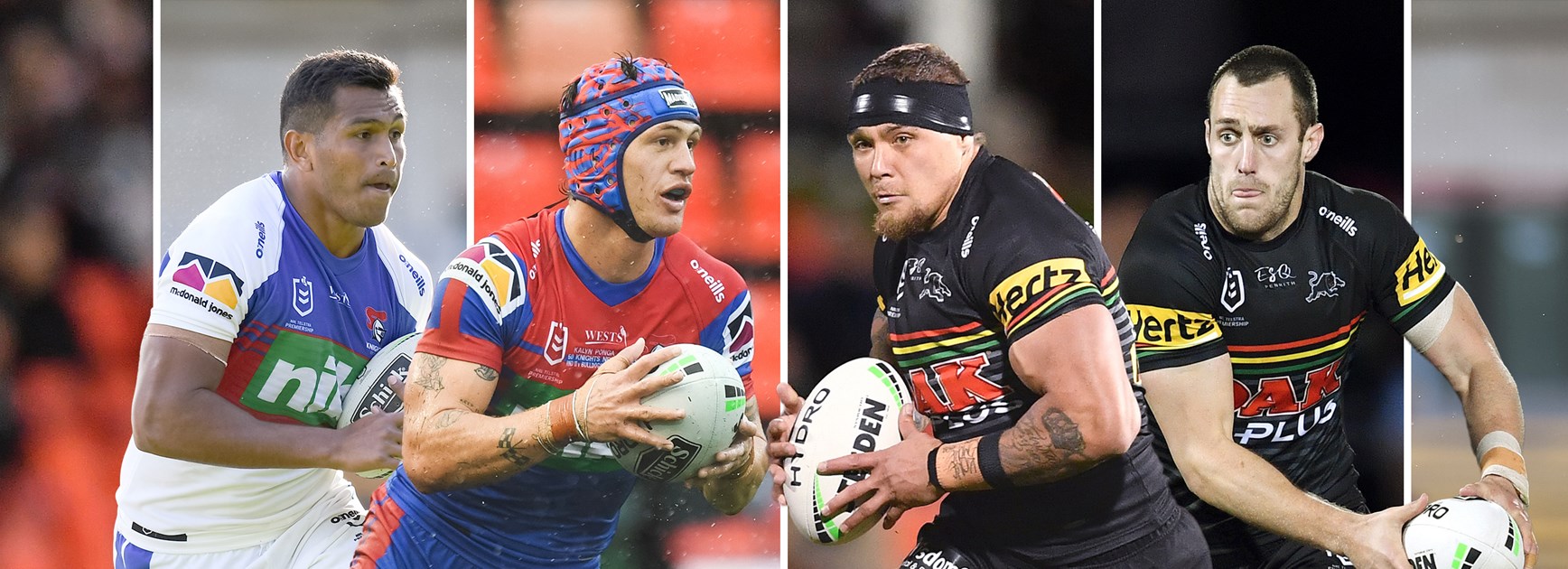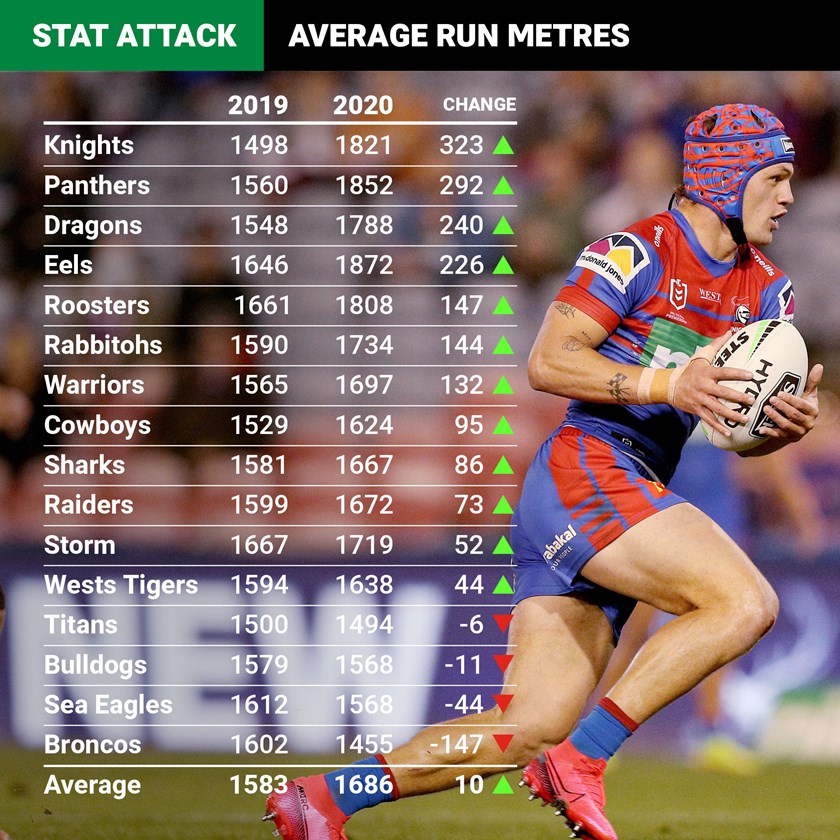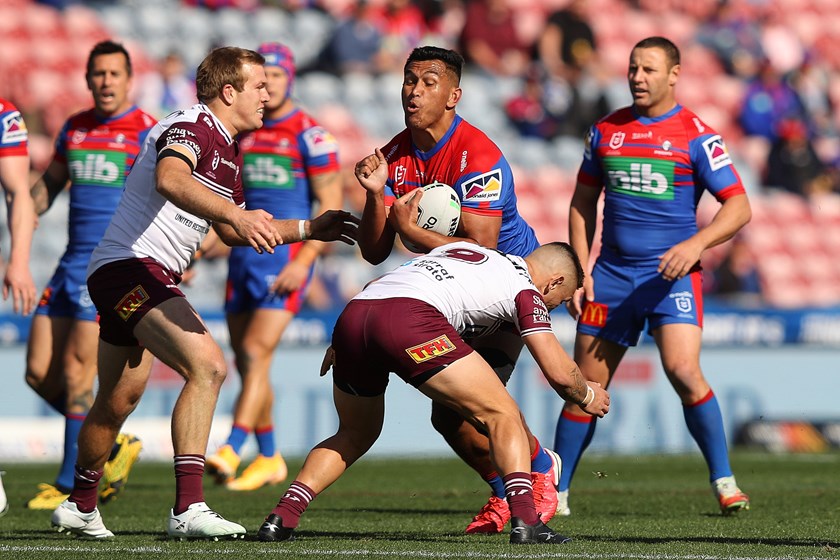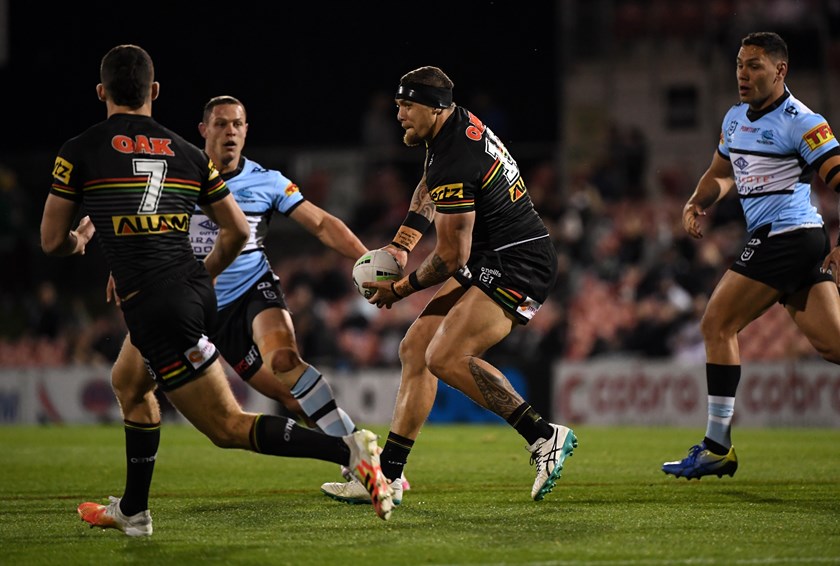
In a season where clubs on average are running for 100 extra metres per game, a huge spike in yardage has underpinned the resurgence of the table-topping Panthers and a Newcastle side set for its first finals appearance since 2013.
While at the other end of the spectrum, Brisbane have suffered a massive drop-off in 2020 while fellow strugglers Canterbury, Gold Coast and Manly are also down on last season's numbers.
Hard-running Knights go backwards against Warriors
It's no coincidence that Newcastle's worst performance of the year in last week's 36-6 loss to the Warriors also featured easily their worst effort in run metres of 2020; their 1246 metres gained fell 400 metres short of their second-worst, the 1645 they made in round one, also against the Warriors.
That figure came pre-lockdown and before the rule changes increased the ball-in-play time; their worst post-rule change run metre totals prior to last week both came against the Storm at 1666 in round 12 and 1696 in round five.
Round 16 also featured their worst possession count of the year with just 36% of the ball; they were forced into four line drop-outs and lost the penalty count 8-2, conceding 812 more run metres than they made (2059 to 1247).

Easy fix? Knights know the formula
Adam O'Brien in theory shouldn't have trouble getting his team back to what worked in winning nine and drawing one of their 15 previous games this year.
The turnaround in Newcastle's running game from 2019 is dramatic. Last year they were dead last for metres per game with 1498 per week. This year, even with last week's stumble, they are third best behind only the Eels and Panthers with 1821 per week.
Their improvement of 323 per game is easily the best of any team, with the Panthers next-most improved with 292 per game.
There are plenty of things that factor into such a turnaround: controlling possession, earning repeat sets, scoring points (thereby receiving a kick-off), minimising errors and penalties and so on.
Another huge factor is good hard running, and the Knights have a few players in particular earning far more metres than they did last year.
Kalyn Ponga is making an extra 70 metres per game on his own, up from 128m last year across 20 games to 191 per week in 15 games so far this year.
The team has missed Origin prop Dan Saifiti during his recent injury lay-off given he has upped his contribution by 57 metres per game (from 94 to 151).

His brother Jacob wasn't used much last year but his 118 per game this year is 68 metres per week better than his 50 per game in 2019.
Bradman Best also didn't see much footy last year and he too has been missed since his ankle injury, given his 152 metres per game this year (up 62 from his 90 per game last year).
Kurt Mann (44m), Mitch Barnett (35m), Hymel Hunt (32m), Herman Ese'ese (27m), Lachlan Fitzgibbon (22m) and David Klemmer (10m) are all carrying the ball further this year than last.
No hiccups for Penrith
The Panthers were the fifth-lowest metre-getters last year, making just 1560 metres per game but this season they are second behind Parramatta with 1852 per game and their increase of +292 per week trails only Newcastle.
They may slightly trail the Eels for average metres but they have been remarkably consistent, only three times failing to better 1700 metres per game – once pre-lockdown, as well as in their only loss of the season against the Eels, and also in a gritty round 13 win over Canberra in a game that had plenty of stoppages and relatively low ball-in-play time.

Prop James Fisher-Harris has been massive in this department, reducing his defensive workload from 43 tackles per game to 35 and upping his run metres from 133 to 184 – a gain of 51 metres per match.
He's had plenty of assistance from Moses Leota (42m), Josh Mansour (27m), James Tamou (21m) and Dylan Edwards (16m).
The only time all year the Panthers have run fewer metres than their opposition was in that sole loss to Parramatta.
Eels, Dragons also up; Broncos, Sea Eagles struggle
The Eels were the third-best yardage team last year behind the Roosters and Storm and registered the fourth-biggest increase to be the best running side of 2020, up 226m per game to 1872 helping them to their current third-place billing on the ladder after 16 rounds.
In a stat that is usually highly correlated with success, the Dragons buck the trend. Only the Eels, Panthers, Knights and Roosters make more metres than the Red V, who have shown the third-most improvement of any club, running 240 more metres per game than they did last year.
However they still sit outside the top eight and their two best run tallies of the season came in the first two weeks after the resumption.
Those two matches – which they lost 18-0 to the Warriors and 22-2 to last-placed Canterbury – were arguably their two worst performances of the season and it should be noted in both games their opponents ran for even more metres.
The return of the cut-out ball
At the lower end of the table the struggling Broncos have dropped the most of the four clubs running for fewer metres than they did in 2019, down 147 per game. You can read more about their statistical struggles here.
Manly started off from the round three resumption with a bang, running 1930 metres in a win over Canterbury, and were hanging with the pack for eight rounds after that.
However their recent five-game losing streak has coincided with a huge drop in their weekly run metres, gaining around 1300 metres in losses to Penrith and Souths and running just 1100 in last week's dire loss to the Storm.


